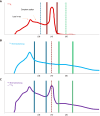Same day yttrium-90 radioembolization with single photon emission computed tomography/computed tomography: An opportunity to improve care during the COVID-19 pandemic and beyond
- PMID: 34040704
- PMCID: PMC8131908
- DOI: 10.4251/wjgo.v13.i5.440
Same day yttrium-90 radioembolization with single photon emission computed tomography/computed tomography: An opportunity to improve care during the COVID-19 pandemic and beyond
Abstract
Background: The coronavirus disease 2019 (COVID-19) pandemic has made it more challenging for patients to undergo yttrium-90 (Y-90) radioembolization (RE). Same day Y-90 RE provides an opportunity to minimize logistical challenges and infection risk associated with COVID-19, thus improving patient access.
Aim: To describe the use of same day Y-90 RE with routine single photon emission computed tomography/computed tomography (SPECT/CT) in order to optimize therapy.
Methods: All patients were selected for Y-90 RE through a multidisciplinary tumor board, and were screened and tested for COVID-19 infection per institutional protocol. A same day procedure was developed, consisting of angiography, imaging, and Y-90 resin particle delivery. Routine SPECT/CT after technetium-99m macroaggregated albumin (Tc-99m MAA) administration was performed for assessment of arterial supply, personalized dosimetry, and extrahepatic activity. Post-treatment Y-90 bremsstrahlung SPECT/CT was performed for confirmation of particle delivery, by utilization of energy windowing to limit signal from previously administered Tc-99m MAA particles.
Results: A total of 14 patients underwent same day Y-90 RE between March and June 2020. Mean lung shunt fraction was 6.13% (range 3.5%-13.1%). Y-90 RE was performed for a single lesion in 7 patients, while the remaining 7 patients had treatment of multifocal lesions. The largest lesion measured 8.3 cm. All patients tolerated the procedure well and were discharged the same day.
Conclusion: Same day Y-90 RE with resin-based microspheres is feasible, and provides an opportunity to mitigate infection risk and logistical challenges associated with the COVID-19 pandemic and beyond. We recommend consideration of SPECT/CT, especially among patients with complex malignancies, for the potential to improve outcomes and eligibility of patients to undergo same day Y-90 RE.
Keywords: COVID-19; Dosimetry; Same day; Selective internal radiotherapy; Single photon emission computed tomography/computed tomography; Transarterial radioembolization; Yttrium-90 radioembolization.
©The Author(s) 2021. Published by Baishideng Publishing Group Inc. All rights reserved.
Conflict of interest statement
Conflict-of-interest statement: No authors received specific funding for the development of this manuscript. Kokabi N conducts Y-90 radioembolization research partially funded by Sirtex Medical Ltd; Duszak R receives research support from the Harvey L. Neiman Health Policy Institute.
Figures





Similar articles
-
Personalized predictive lung dosimetry by technetium-99m macroaggregated albumin SPECT/CT for yttrium-90 radioembolization.EJNMMI Res. 2014 Jun 29;4:33. doi: 10.1186/s13550-014-0033-7. eCollection 2014. EJNMMI Res. 2014. PMID: 25024931 Free PMC article.
-
Predictive Value of 99mTc-MAA SPECT for 90Y-Labeled Resin Microsphere Distribution in Radioembolization of Primary and Secondary Hepatic Tumors.J Nucl Med. 2015 Nov;56(11):1654-60. doi: 10.2967/jnumed.115.162685. Epub 2015 Aug 27. J Nucl Med. 2015. PMID: 26315830
-
Outpatient single-session yttrium-90 glass microsphere radioembolization.J Vasc Interv Radiol. 2014 Feb;25(2):266-70. doi: 10.1016/j.jvir.2013.11.005. Epub 2013 Dec 12. J Vasc Interv Radiol. 2014. PMID: 24332243
-
Advances in SPECT for Optimizing the Liver Tumors Radioembolization Using Yttrium-90 Microspheres.World J Nucl Med. 2015 May-Aug;14(2):75-80. doi: 10.4103/1450-1147.157120. World J Nucl Med. 2015. PMID: 26097416 Free PMC article. Review.
-
Clinical impact of (99m)Tc-MAA SPECT/CT-based dosimetry in the radioembolization of liver malignancies with (90)Y-loaded microspheres.Eur J Nucl Med Mol Imaging. 2016 Mar;43(3):559-75. doi: 10.1007/s00259-015-3157-8. Epub 2015 Sep 4. Eur J Nucl Med Mol Imaging. 2016. PMID: 26338177 Free PMC article. Review.
Cited by
-
Radiation Segmentectomy for the Treatment of Hepatocellular Carcinoma: A Practical Review of Evidence.Cancers (Basel). 2024 Feb 4;16(3):669. doi: 10.3390/cancers16030669. Cancers (Basel). 2024. PMID: 38339418 Free PMC article. Review.
-
CT texture features and lung shunt fraction measured using 99mTc-macroaggregated albumin SPECT/CT before trans-arterial radioembolization for hepatocellular carcinoma patients.Sci Rep. 2023 Dec 15;13(1):22288. doi: 10.1038/s41598-023-49787-7. Sci Rep. 2023. PMID: 38097801 Free PMC article.
-
SIRT in 2025.Cardiovasc Intervent Radiol. 2022 Nov;45(11):1622-1633. doi: 10.1007/s00270-022-03228-6. Epub 2022 Aug 8. Cardiovasc Intervent Radiol. 2022. PMID: 35941244 Free PMC article. Review.
-
Effect of teach-back health education combined with structured psychological nursing on adverse emotion and patient cooperation during 99mTc-3PRGD2.SPECT/CT.World J Clin Cases. 2022 Dec 6;10(34):12551-12558. doi: 10.12998/wjcc.v10.i34.12551. World J Clin Cases. 2022. PMID: 36579107 Free PMC article.
-
Management of Liver Tumors during the COVID-19 Pandemic: The Added Value of Selective Internal Radiation Therapy (SIRT).J Clin Med. 2021 Sep 22;10(19):4315. doi: 10.3390/jcm10194315. J Clin Med. 2021. PMID: 34640332 Free PMC article.
References
-
- Kruskal JB, Kung JW. The 2015 RadioGraphics Monograph Issue: Quality, Safety, and Noninterpretive Skills. Radiographics. 2015;35:1627–1629. - PubMed
-
- Salem R, Lewandowski RJ, Sato KT, Atassi B, Ryu RK, Ibrahim S, Nemcek AA Jr, Omary RA, Madoff DC, Murthy R. Technical aspects of radioembolization with 90Y microspheres. Tech Vasc Interv Radiol. 2007;10:12–29. - PubMed
-
- Salem R, Lewandowski RJ, Mulcahy MF, Riaz A, Ryu RK, Ibrahim S, Atassi B, Baker T, Gates V, Miller FH, Sato KT, Wang E, Gupta R, Benson AB, Newman SB, Omary RA, Abecassis M, Kulik L. Radioembolization for hepatocellular carcinoma using Yttrium-90 microspheres: a comprehensive report of long-term outcomes. Gastroenterology. 2010;138:52–64. - PubMed
-
- Llovet JM, Real MI, Montaña X, Planas R, Coll S, Aponte J, Ayuso C, Sala M, Muchart J, Solà R, Rodés J, Bruix J Barcelona Liver Cancer Group. Arterial embolisation or chemoembolisation versus symptomatic treatment in patients with unresectable hepatocellular carcinoma: a randomised controlled trial. Lancet. 2002;359:1734–1739. - PubMed
LinkOut - more resources
Full Text Sources
Other Literature Sources

